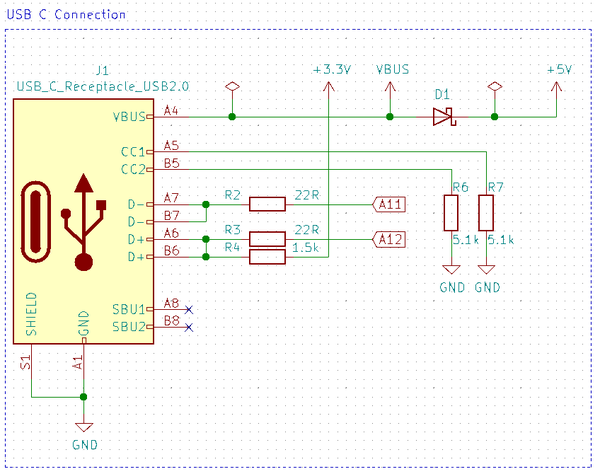Difference between revisions of "STM32 USB Device Renumeration"
m (Lth moved page STM32 USB Device Re-enumeration to STM32 USB Device Renumeration) |
|||
| Line 28: | Line 28: | ||
What this does is essentially to configure the PA12 pin (USB D+) as a GPIO output pin and pull that to GND for 50 ms, before letting the USB initialisation continue as normal. The result is that the host notice the device has been disconnected and thus tries to re-enumerate immediately. | What this does is essentially to configure the PA12 pin (USB D+) as a GPIO output pin and pull that to GND for 50 ms, before letting the USB initialisation continue as normal. The result is that the host notice the device has been disconnected and thus tries to re-enumerate immediately. | ||
| + | |||
| + | While being pulled low, the GPIO pin (D+) is going to sink 3.3V over a 1.5 kOhm resistor, so it will sink about 2.2 mA. That is well within spec and shouldn't cause any issues as it will only be pulled low for 50 ms. | ||
After adding the above piece of code, the device will re-enumerate each time it is flashed (or otherwise restarted). | After adding the above piece of code, the device will re-enumerate each time it is flashed (or otherwise restarted). | ||
Revision as of 03:10, 9 February 2022
USB devices need a 1.5 kOhm pull-up resistor on the D+ line in order for them to identify as devices (rather than hosts). On many STM32 MCUs this pull-up resistor is built-in (all MCUs with USB OTG). However, on the "device only" STM32's, like the STM32F103, this is not the case, so in modules using those processors one often see something like this in the schematics:
This generally works just fine with one noticeable exception - since the D+ line is permanently pulled high, the device will not re-enumerate when it is soft restarted (for example when flashing new firmware). This is of course a major PITA when doing USB related development.
Fortunately there is a rather elegant work-around. Before actually initialising the USB device, in "usb_device.c", add the following at the top of the MX_USB_DEVICE_Init function:
/* USER CODE BEGIN USB_DEVICE_Init_PreTreatment */
/*
* Force host to re-enumerate device
*/
GPIO_InitTypeDef GPIO_InitStruct = { 0 }; // All zeroed out
GPIO_InitStruct.Pin = GPIO_PIN_12; // Hardcoding this - PA12 is D+
GPIO_InitStruct.Mode = GPIO_MODE_OUTPUT_PP; // Push-pull mode
GPIO_InitStruct.Pull = GPIO_PULLDOWN; // Resetting so pull low
GPIO_InitStruct.Speed = GPIO_SPEED_HIGH; // Really shouldn't matter in this case
HAL_GPIO_Init(GPIOA, &GPIO_InitStruct); // Initialize with above settings
HAL_GPIO_WritePin(GPIOA, GPIO_PIN_12, GPIO_PIN_RESET); // Yank low
HAL_Delay(50); // Enough time for host to disconnect device
HAL_GPIO_WritePin(GPIOA, GPIO_PIN_12, GPIO_PIN_SET); // Back high - so host will enumerate
/* USER CODE END USB_DEVICE_Init_PreTreatment */
What this does is essentially to configure the PA12 pin (USB D+) as a GPIO output pin and pull that to GND for 50 ms, before letting the USB initialisation continue as normal. The result is that the host notice the device has been disconnected and thus tries to re-enumerate immediately.
While being pulled low, the GPIO pin (D+) is going to sink 3.3V over a 1.5 kOhm resistor, so it will sink about 2.2 mA. That is well within spec and shouldn't cause any issues as it will only be pulled low for 50 ms.
After adding the above piece of code, the device will re-enumerate each time it is flashed (or otherwise restarted).
